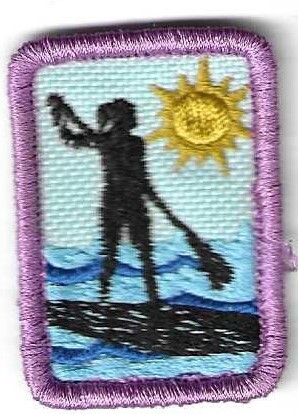Paddle Boarding--Ella J Embroidery
Requirements:
Paddle boarding
*As with any activity concerning water, please use your best discretion. If you or your group is unfamiliar
with this activity it is recommended that you seek advice from a certified instructor. Use these activities
as a guideline to get you started*
Stand up Paddle boarding or SUP is a fun an relaxing activity for all ages.
When paddle boarding, you shouldn’t forget to tether yourself to your board with a leash.
1) Why is it important to wear a leash while paddle boarding?
2) There are two types of SUP leashes? What are the two types and under what conditions would
you use each type?
3) There are 3 attachment points for SUP leashes. What are the 3 points and under what
conditions would you use each attachment point?
Choosing your board
4) Typically, it’s best to start with a thick and wide board that’s easy to balance yourself on.
Find out about a few other types of boards and what skill levels would be required to use them.
5) When choosing the right type of paddle, you should use a paddle that is tall enough that you
don’t have to bend or stoop while you’re paddling. Why is having proper body posture
important while you’re paddling?
Wind conditions
While standing on your board, your body tends to act like a sail—which means strong winds will likely
steer you and your board every which way.
6) Learn more about how to check wind speed and direction before you hit the water.
7) In the event that the wind speed and direction becomes a bit too much for you to handle while
you’re in the water, what should you do?
Correct paddle technique
One of the most common mistakes paddle boarders make is that they tend to hold the paddle
incorrectly. If you’re just starting out and you’ve had no training on stand up paddle boarding,
your instinct would be to hold it in a way so that the bent part of the blade is facing you, so you
can “scoop” yourself forward.
As it turns out, that’s actually not the right way to use your paddle as it can cause you to lose
your balance. Flip the paddle so that the bent part is facing away from you.
Mind your hand placement. Having your hands too close together on the paddle can limit the
power of your strokes and may even tire you out faster.
8) Here’s how to find out where you should position your hands on the paddle:
Stand up straight and grip the non-blade end of the paddle.
Hold the paddle horizontally over your head with both hands, and then rest the shaft on
the top of your head.
Make sure that the shaft is parallel to your shoulders and that the arm that’s holding the
grip creates a perfect 90-degree angle.
Move the other hand (the one that’s not holding the grip) along the shaft until you create
a perfect 90-degree angle with that arm as well.
Now that you have the proper equipment and proper technique, lets hit the water.
9) While paddling why should you use your body core for strength, not your arms.
10) Keep your head up, bear your weight on the balls of your feet, fall away from your board,
give other boarders plenty of space, don’t take on waves or winds that you can handle
and most importantly HAVE FUN!!!!
